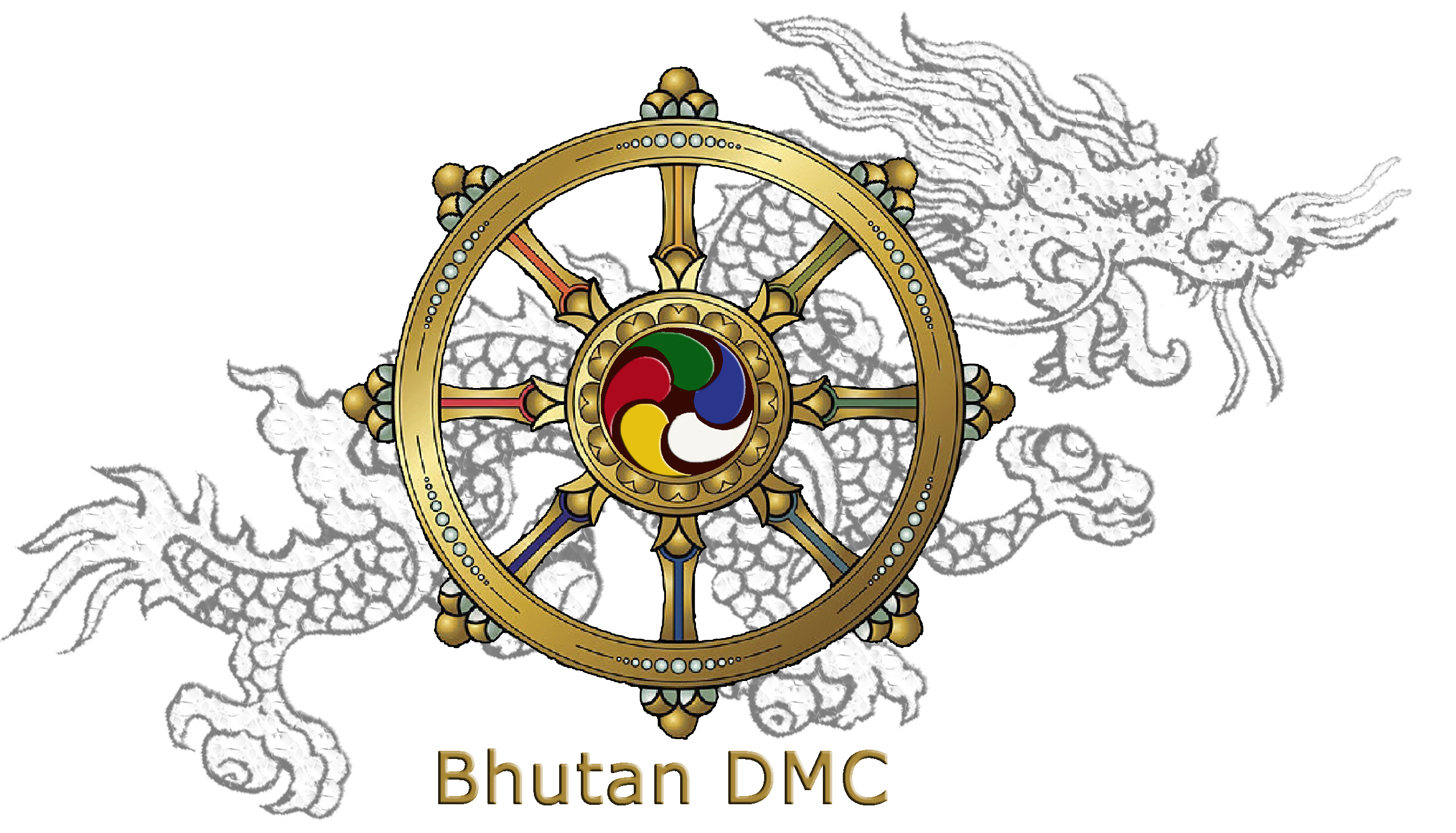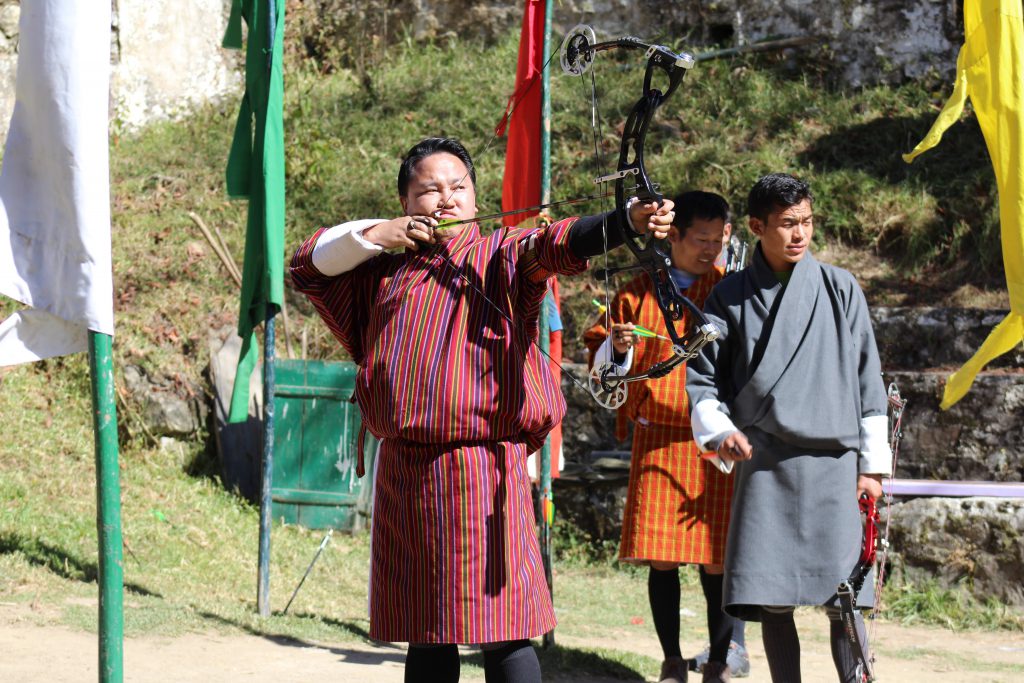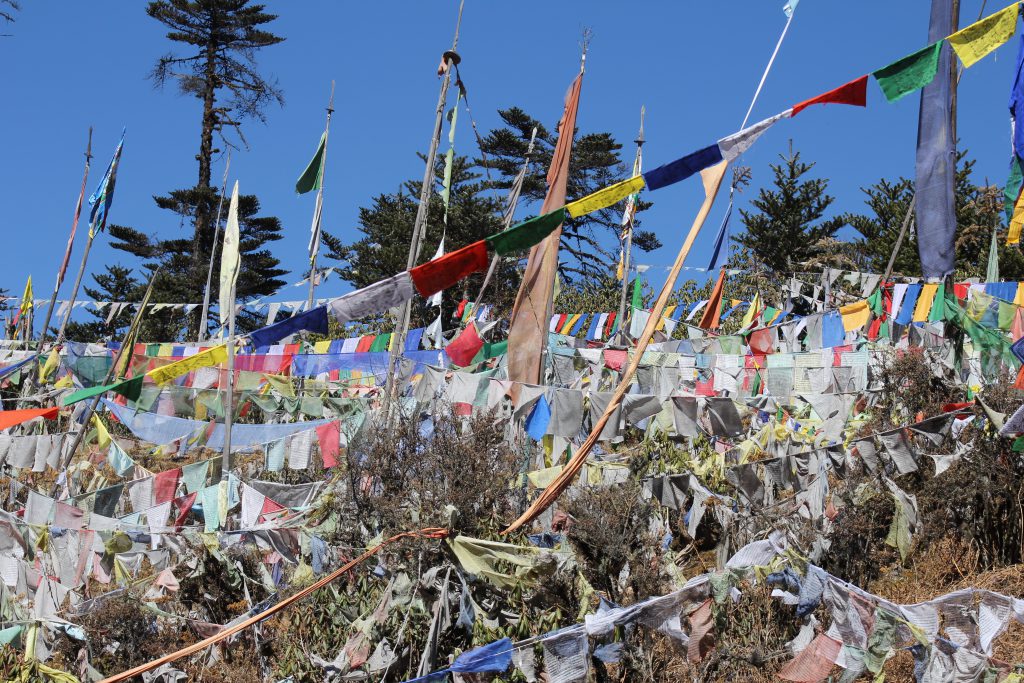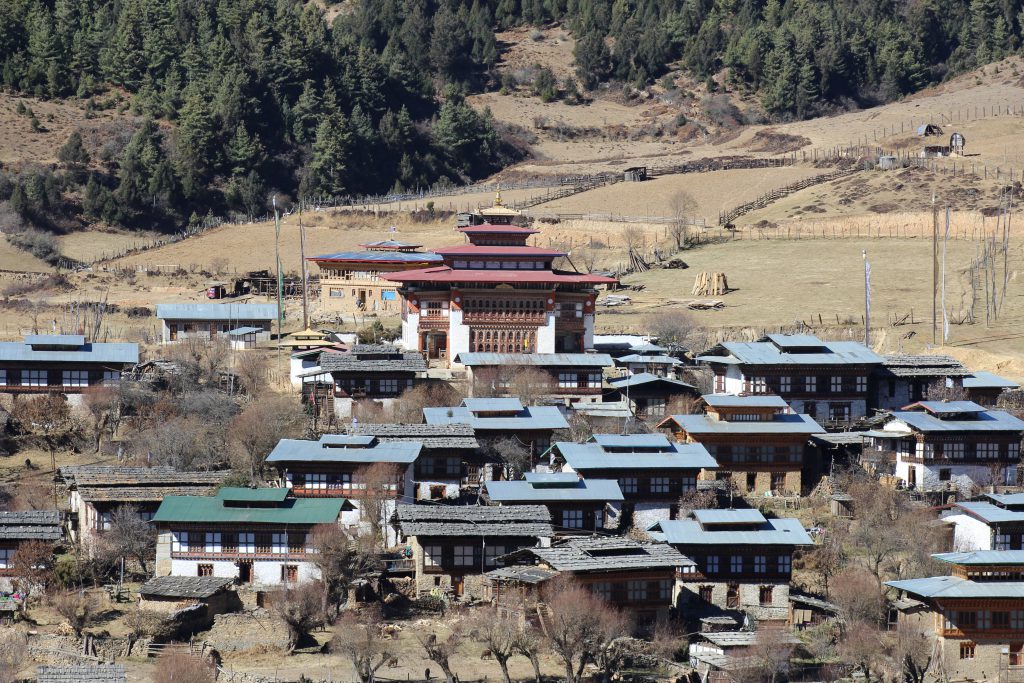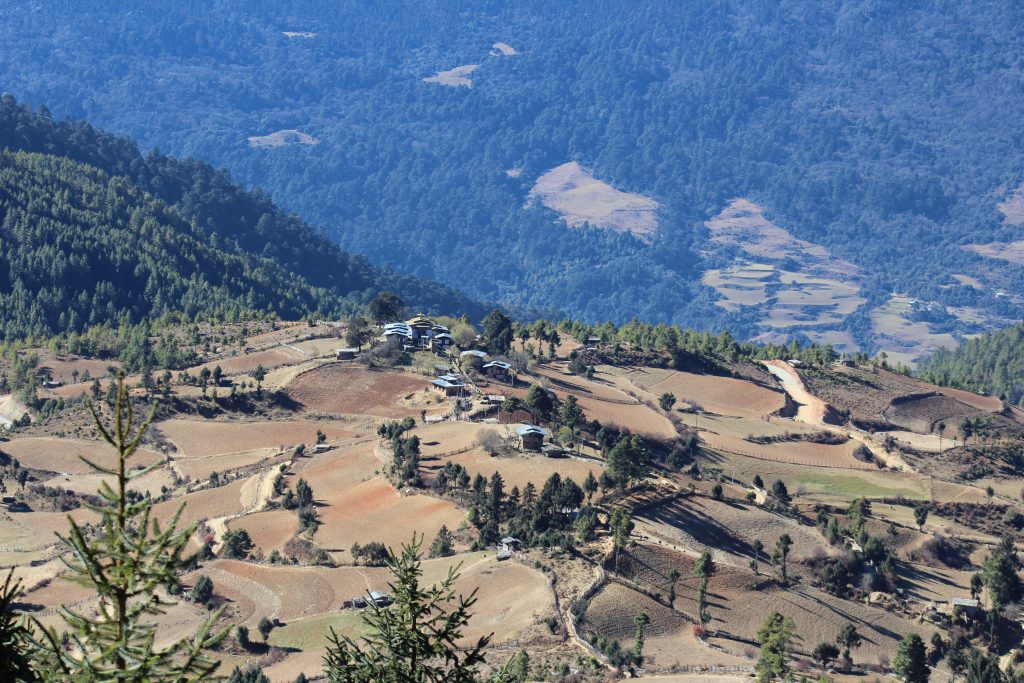The Kingdom of Bhutan hidden in the heart of the high Himalayas between India and Tibet, is an exotic land of snow-clad peaks and lush valleys, dense forests and clear running springs, a pristine ecology and an incredible wealth of wildlife. Sparsely populated, this landlocked nation is the last surviving Mahayana Buddhist state in the world today. A land that offers travelers a rare opportunity to discover the richness of nature and the simplicity of life, among warm-hearted and friendly people.
Day 1
Day 1- Arrive Paro by Flight & transfer to Thimphu (55km, approx. 1.1/2-hour drive)
The flight to Paro is one of the most spectacular in entire Himalayas. Whether flying along the Himalayan range from Kathmandu or over the foothills from Kolkatta, the journey offers fascinating views and an exciting descent into the Kingdom. Bhutan’s first gift as you disembark from the aircraft will be cool, clean fresh mountain air. After immigration formalities and baggage collection, you will be met by our representative, and afterwards drive to Thimphu, the capital town of Bhutan with en-route stop at Chuzom, the confluence of Thimphu and Paro rivers. Three different style of stupas; Tibetan, Nepalese and Bhutanese adorn this confluence.
On arrival, in Thimphu check-into the hotel. The capital town of Bhutan and the centre of government, religion and commerce, Thimphu is a unique city with unusual mixture of modern development alongside ancient traditions. With the population of about 1,00,000 it is perhaps still the world’s only capital city without a traffic light.
Evening an exploratory walk around Thimphu main street and market area.
Overnight at the hotel in Thimphu. (Altitude 2,320 m)
Day 2
Day 2- Thimphu
After breakfast, drive to visit Buddha Dordenma, located atop a hill in Kuenselphodrang Nature Park and overlooks the Southern entrance to Thimphu Valley. The statue fulfils an ancient prophecy dating back to the 8th century A.D that was discovered by Terton Pema Lingpa (Religious Treasure Discoverer) and is said to emanate an aura of peace and happiness to the entire world. This massive statue of Shakyamuni made of bronze and is gilded in gold, measures 51.5 meters in height, making it one of the largest statues, in Bhutan. 125,000 smaller Buddha statues have been placed within the Buddha Dordenma statue, each of these also have been cast in bronze and gilded. The throne that the Buddha Dordenma sits upon is a large meditation hall.
Then, visit King’s Memorial Chorten continuously circumambulated by people, murmuring mantras and spinning their prayer wheels. Construction of this landmark was the idea of Bhutan’s third king, His Majesty Jigme Dorji Wangchuk (“the father of modern Bhutan”) who has wished to erect monument to world peace and prosperity. Completed in 1974 after his untimely death, it serves both as a memorial to the Late King and as a monument to peace.
Afternoon the visits include:
Textile Museum: is worth a visit to experience the living national art of weaving. Exhibitions introduce the major weaving techniques, styles of local dress and textiles made by women and men.
Folk Heritage Museum: The Museum is dedicated to connecting people with the rich Bhutanese Folk heritage and rural history through exhibits, demonstrations, educational programs and documentation of Bhutanese rural life.
Trashichhoedzong: This is the center of government and religion, site of monarch’s throne room and seat of Je Khenpo or Chief Abbot. Built in 1641 by the political and religious unifier of Bhutan, Shabdrung Ngawang Namgyal, it was reconstructed in 1960s in traditional Bhutanese manner, without nails or architectural plans.
Evening time can be spent strolling through Thimphu city centre and local crafts bazaar, to browse through example of Bhutan’s fine traditional arts. Here you can buy hand-woven textiles, thangkha paintings, masks, ceramics, slate and wood carvings, jewelry, interesting items made from local materials.
Overnight at the hotel in Thimphu. (Altitude 2,320 m)
Day 3
Day 3- Thimphu – Gangtey (150km, approx. 5-hour drive)
After breakfast, drive up to Dochu-la pass (3,088m/ 10,130 ft) stopping briefly here to take in the view and admire the chorten, mani wall, and prayer flags which decorate the highest point on the road. If skies are clear, the following peaks can be seen from this pass (left to right): Masagang (7,158m), Tsendagang (6,960m), Terigang (7,060m), Jejegangphugang (7,158 m ), Kangphugang (7,170 m ), Zongphugang (7, 060 m ), a table mountain that dominates the isolated region of Lunana – finally Gangkar puensum, the highest peak in Bhutan at 7,497m.
At Dochula Pass, 108 chortens or stupas known as Druk Wangyal Chortens have been built by Ashi Dorji Wangmo Wangchuk, the eldest Queen Mother. These chortens are built in three layers, the first lowest level layer has forty-five chortens, the second has thirty-six and the top layer has twenty-seven, built around the main chorten.
Then drive onto Gangtey, passing through dense forests of oak and rhododendron tress.
The valley of Gangtey is one of the most beautiful and unspoiled places in Bhutan. The surprise of finding such a wide, flat valley without any trees after the hard climb through dense forests is augmented by an impression of vast space and is an extremely rare experience in Bhutan where most of the valleys are tightly enclosed. A few kilometers beyond the Gangtey Monastery, on the valley floor lies the village of Phobjikha.
Afternoon explore fascinating Phobjikha valley. This place is the winter home of black necked cranes that migrate from the arid plains in the north to pass winter in milder and lower climate. The valley boasts two beautiful meandering rivers, Nakay Chhu (Chhu Naap-black water) and Gay Chhu (Chhu Karp-white water).
Overnight at the hotel in Gangtey. (Altitude 3,000m)
Day 4
Day 4- Gangtey – Bumthang (153km, approx. 6-hour drive)
Morning after breakfast visit Gangtey Goempa (monastery), perched on a ridge overlooking the valley. It is directed by Gangtey Tulku, the ninth reincarnation of Pema Lingpa—a famous Buddhist saint and teacher.
Then drive to Trongsa crosses Pelela pass (3,300 m), the traditional boundary between east and west. The pass is marked by a large prayer flag and the ground is covered with high altitude dwarf bamboo. Stop en route at Chendbji Chorten, the stupa built in 18th century by a Lama named Shida. It is Nepalese in style with eyes painted at four cardinal points.
Trongsa town, perched on steep slopes above a river gorge, forms the central hub of the nation and is the place from where attempts at unifying the country were launched. The landscape around Trongsa is spectacular.
Also visit Trongsa Dzong, built in 1648 it was the seat of power over central and eastern Bhutan. Both the first and second Kings of Bhutan ruled the country from this ancient seat.
Then continue drive to Bumthang across Yutong-la pass (3,400m/ 11,155 ft). The road winds steeply up to the pass from Trongsa, then runs down through coniferous forest into a wide, open cultivated valley known as the Chumey valley.
Take a short stop at Chumey, a wide fertile valley where wheat, barley, potatoes and buckwheat are cultivated. Chumey is particularly known for its famous wool weaving called ‘Bumthang Yathra’.
On arrival in Bumthang, check in to the hotel.
Overnight at the hotel in Bumthang. (Altitude 2600m)
Day 5
Day 5- Bumthang
Bumthang is the general name given to combination of four valleys – Chumey, Choekhor, Tang and Ura with altitude varying from 2,600m to 4,000m. It is home to many of prominent Buddhist temples and monasteries.
After breakfast, visit Jambey Lhakhang. This monastery was built in the 7th century by Tibetan King, Songtsen Gampo. It is one of the 108 monasteries built by him to subdue evil spirits in the Himalayan region. Its present architectural appearance dates from the early 20th century.
Then visit to Kurje Lhakhang, consisting of three temples. The one on the right was built in 1652 on the rack face where Guru meditated in the 8th century. Second temple is built on the site of a cave containing a rock with the imprint of Guru’s body and is therefore considered the most holy. The third temple was built in 1990s by Ashi Kesang, the Queen Mother. These three temples are surrounded by a 108 chorten wall.
Afterwards visit to Jakar Dzong. Founded by great grand-father of the first Shabdrung, the Dzong was initially built as a monastery in 1549. It was upgraded after the Shabdrung had firmly established his power in 1646. The Dzong is now used as administrative centre for Bumthang valley and houses the regional monk body.
Post lunch visit Tamshing Lhakhang, the temple founded in 1501 by Terton Pema Lingpa, the re-incarnation of Guru Padsambhava. The monastery has very ancient religious paintings like 1,000 Buddhas and 21 Taras (female form of Buddhistava). The temple was restored at the end of the 19th century.
Then drive to Lhodrak Kharchhu Monastery. Located above the main town, the monastery was founded by Namkhai Nyingpo Rinpoche in 1984 who was recognized at a very young age by H.H. the 14th Dalai Lama and H.H. 16th Karmapa as the reincarnation of a Tibetan lama. The monastery has become part of an extensive effort to preserve and revitalize Tibetan culture. The monks regular curriculum include reading, memorizing the daily prayers, learning dharma dances, drawing mandalas, learning the melodies of sacred rituals, learning the use of ceremonial instruments and the art of making sacrificial objects, grammer, poerty, karika along with the basics of contemplation and instruction on the different stages of tantra.
Evening take a stroll around centre of Bumthang town, exploring shops and local market.
Overnight at the hotel in Bumthang. (Altitude 2600m)
Day 6
Day 6- Bumthang – Punakha (215km, approx. 7-hour drive)
After breakfast, depart for the lengthy drive to Punakha.
En route visit Ta Dzong, recently opened fort in Trongsa. The Ta Dzong, a cylindrical stone structure rising five stories, was built in 1652 by Chogyal Minjur Tempa. After more than 350 years, it has been resurrected into a classy museum, that represents a tasteful blend of tradition and modernity.
Evening at leisure in Punakha.
Overnight at hotel in Punakha. (Altitude 1300m)
Day 7
Day 7- Punakha
After breakfast, visit Sangchhen Dorji Lhuendrup Lhakhang Nunnery. Perched on a ridge amid pine trees and overlooking valleys of Punakha and Wangdue gleams Sangchhen Dorji Lhuendrup temple. It houses a 14-foot main bronze statue of Avalokiteshvara and of Guru Padsambhava, Gautam Buddha, Zhabdrung Ngawang Namgyal, Tsela Namsum, the 21 Taras and Tsepamay (Buddha of longevity). The temple complex also houses a permanent higher learning and meditation centre for nuns where, apart from religious training, it provides life skill training such as tailoring, embroidery, statue making and thangkha painting.
Then visit Punakha Dzong or (Palace of Great Happiness), built in 1637 by Shabdrung Ngawang Namgyal, at the junction of the Phochu and Mochu rivers. This majestic dzong served as both the religious and the administrative center of Bhutan in the past. It measures some 600 by 240 feet and has a six-story, gold-domed tower. Inside are courtyards and religious statuary that hint at the depth of history and spiritual tradition embodied here. Your guide will illuminate your understanding of this intricate culture that is exotic to us, though long established here.
Afternoon a beautiful hike (total about 2 hours round trip walk) takes you to the regal Khamsum Yuelley Namgel Chorten, which was built by the Queen Mother of Bhutan to remove negative forces and promote peace, stability and harmony in the changing world. The Chorten dominates the upper Punakha Valley with commanding views across the Mo Chhu river and up towards the mountainous peaks of Gasa and beyond.
Overnight at the hotel in Punakha. (Altitude 1,300m)
Day 8
Day 8- Punakha – Paro (125 km, approx. 4.1/2-hour drive)
After breakfast drive back to Paro descending back down from Dochu La, follow the way back up the dramatic Wang Chhu and Paro Chhu river valleys, before crossing through Paro town towards the north end of the valley.
At Dochula pass, visit to Druk Wangyal Lhakhang (temple), built in honour of His Majesty the fourth Druk Gyalpo, Jigme Singye Wangchuck. The past and future appears to merge in the details of the temple and its structure tells the story of a supreme warrior figure, whose vision pierces the distant future in a fine blend of history and mythology.
Later in the day after checking into hotel at Paro, proceed to visit Ta Dzong, originally built as Watchtower, which now houses National Museum. The extensive collection includes antique thangkha paintings, textiles, weapons & armour, household objects and a rich assortment of natural and historic artifacts.
Then walk down the trail to visit Rinpung Dzong, meaning (‘fortress of the heap of jewels’), which has a long and fascinating history. Along the wooden galleries lining the inner courtyard are fine wall paintings illustrating Buddhist lore such as four friends, the old man of long life, the wheel of life, scenes from the life of Milarepa, Mount. Sumeru and other cosmic Mandala.
Evening to explore Paro city centre.
Overnight at the hotel in Paro. (Altitude 2,280m)
Day 9
Day 9- Paro
After breakfast excursion to Taktshang Monastery (approx. 5 hours round trip walk). It is one of the most famous of Bhutan’s monasteries, perched on the side of a cliff 900m above the Paro valley floor. It is said that Guru Rinpoche arrived here on the back of a tigress and meditated at this monastery and hence it is called ‘Tiger’s Nest’. This site has been recognized as a most sacred place and visited by Shabdrung Ngawang Namgyal in 1646 and now visited by all Bhutanese at least once in their lifetime.
OR
After breakfast, driving excursion to Chelela pass.
Chele la (pass), at an elevation 3,988 meters is considered to be one of the highest motorable passes in Bhutan. About an hour’s drive along a thickly forested road, is this Pass-a botanical paradise. The pass provides stunning views of the sacred mountain Jomolhari and Jichu Drake. It is also marked by hundreds of prayer flags fluttering in the wind. During season, here visitors can see cascades of wild roses, purple and yellow primulas, and swathes of deep blue iris covering the forest floor. The top of the pass bloom with rhododendrons in a variety of colours-pale pink, deep pink, burnt orange, mauve, white and scarlet, in season.
Later en route excursion to Dzongdrakha Goempa. Often called as mini Takstang, Dzongdrakha is a cliff-side temple complex on the western side of the Paro Valley. Four shrines make up the complex, dedicated to Drolma (Tara), Tsheringma (Goddess of Longevity), Guru Rinpoche and the Buddha of the Future, Maitreya. Local oral tradition states that when Guru Rinpoche first came to Bhutan, he came from Nepal, first landing at Drakarpo, and then Dzongdrakha before arriving at Taktshang (Tiger’s Nest) farther north up the valley. Located approx 20-minute drive from Paro, these temples are built on a cliff above Bondey village, but the walk is not as strenuous as Taktshang. From the road, it takes only about 30 minutes’ walk to reach here. The Dzongdrakha village has numerous temples and is known for most of their men being either fully ordained monks or gomchens (lay monks who don’t take vows of celibacy). Ironically it is the women who work in the fields and are the bread earners unlike in any other part of the country.
Evening an exploratory walk around main street and market area.
Overnight at the hotel in Paro. (Altitude 2,280m)
Day 10
Day 10- Depart Paro
After early breakfast at the hotel, drive to the airport for flight to your onward destination. Our representative will help you with exit formalities and then bid you farewell.
Image Gallery
